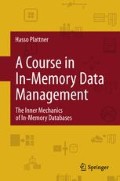Abstract
Using a differential buffer as an additional data structure to improve write performance requires to cyclically combine this data with the compressed main partition. This process is called “merge”.
Access this chapter
Tax calculation will be finalised at checkout
Purchases are for personal use only
References
M. Faust, D. Schwalb, J. Krueger, H. Plattner, Fast lookups for in-memory column stores: group-key indices, lookup and maintenance, in ADMS ’12: Proceedings of the 3rd International Workshop on Accelerating Data Management Systems Using Modern Processor and Storage Architectures at VLDB’12, 2012
J. Krueger, M. Grund, J. Wust, A. Zeier, H. Plattner, Merging differential updates in in-memory column store, in DBKDA, 2011
J. Krueger, M. Grund, A. Zeier, H. Plattner, Enterprise application-specific data management, in EDOC, pp. 131–140, 2010
V. Sikka, F. Färber, W. Lehner, S.K. Cha, T. Peh, C. Bornhövd, Efficient transaction processing in SAP HANA database: the end of a column store myth, in SIGMOD Conference, pp. 731–742, 2012
Author information
Authors and Affiliations
Corresponding author
Self Test Questions
Self Test Questions
-
1.
What is the Merge?
The merge process...
-
(a)
incorporates the data of the write-optimized differential buffer into the read-optimized main store
-
(b)
combines the main store and the differential buffer to increase the parallelism
-
(c)
merges the columns of a table into a row-oriented format
-
(d)
optimizes the write-performance.
-
(a)
-
2.
When to Merge?
When is the merge process triggered?
-
(a)
When the number of tuples within the differential buffer exceeds a specified threshold
-
(b)
When the space on disk runs low and the main store needs to be further compressed
-
(c)
Before each SELECT operation
-
(d)
After each INSERT operation.
-
(a)
Rights and permissions
Copyright information
© 2013 Springer-Verlag Berlin Heidelberg
About this chapter
Cite this chapter
Plattner, H. (2013). The Merge Process. In: A Course in In-Memory Data Management. Springer, Berlin, Heidelberg. https://doi.org/10.1007/978-3-642-36524-9_27
Download citation
DOI: https://doi.org/10.1007/978-3-642-36524-9_27
Published:
Publisher Name: Springer, Berlin, Heidelberg
Print ISBN: 978-3-642-36523-2
Online ISBN: 978-3-642-36524-9
eBook Packages: Business and EconomicsBusiness and Management (R0)

